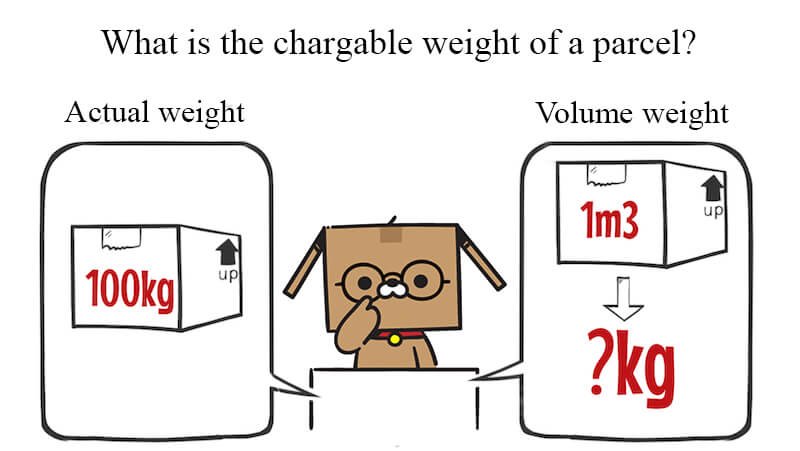
Must-Visit August Pop-up Stores: Stray Kids, One Piece & More
Best Korean Pop-up Stores to Visit in July and August: Stray Kids, One Piece & More Home > Blog > Best Korean Pop-up Stores to

One of the most confusing parts when it comes to calculating shipping costs is associated with chargeable weight. Carriers take both the size and weight of your package into consideration when determining the shipping fees. The weight of the package is important, but sometimes the amount of space it takes up on the truck or plane is given even more consideration. In other words, in logistics, cargo density matters a lot. Let’s start with giving definitions to the key terms.
Shipping costs are based on the greater of the actual weight or dimensional weight. The reason is that in logistics, the amount of space in the warehouse, aircraft, or container is limited. Therefore, it doesn’t sound fair to charge the same costs for a 1kg acoustic guitar or a 1kg jar of jam since the guitar takes as much space as ~20 jars. The scarcity of space involved in the transportation and storage of goods led to an evaluation of weight and volume becoming a common practice.
For that matter automatic (in-line) dimension systems were implemented. To measure the length such systems use speed-based tachometers, while height and width are measured either by a laser scanner or a light curtain. Since automation allows checking the volumetric weight of parcels quickly and cheaply, almost all carriers have such systems in place. Thus, although for those who ship high-density items volumetric weight most likely would not be an issue, for those who whip low-density ones it definitely will.

So, how do we calculate the volumetric weight? Well, it depends on if you want to store the pallets in the warehouse, ship out by sea or by air.
1. Warehouse
When it comes to a warehouse, 1 cubic meter equals one ton.
Pallet/Box: Dimensional (volumetric) weight (t) = Length x Width x Height (m)
Cylinder: Dimensional (volumetric) weight (t) = Height x Diameter x Diameter (m)
Example:
Let’s say you have a standard pallet (i.e., each side is 1m). It weights 1.5t. Thus, 1m3 is considered 1t. 1t is less than 1.5t. As a result, the actual weight will be a chargeable weight.

2. LCL shipments
The rule to calculate volume weight when it comes to LCL shipments is in a sense similar to the warehousing one. Chargeable weight is the greater of actual weight in ton and volumetric weight in cubic meters (CBM).
Dimensional (volumetric) weight = Length x Width x Height (cm) / 1,000,000
Example:
We have a 30 x 50 x 30cm box of 50kg. 50kg equals 0.05t. (30 x 30 x 50) / 1,000,000 = 0.045cbm. Since 0.5t exceeds 0.45cbm, the actual weight will apply.
3. Air freight / Shipping carriers
When it comes to air freight or shipping carriers (DHL, FedEx, etc.) the formula is pretty simple.
Box: Dimensional (volumetric) weight (kg) = Length x Width x Height (m) / DIM*
Cylinder: Dimensional (volumetric) weight (kg) = Height x Diameter x Diameter (cm) / DIM*
*Volumetric divisor provided by a carrier

The key part of the formula is DIM. DIM is a factor used to calculate the volumetric weight of an object. It may vary per carrier and in some cases, per country zone. Usually DIM is either 4000, 5000, or 6000. Currently, most large carriers use cm3/kg, and DIMs of 6000 and 5000 to calculate volume weight. Some carriers have their own calculators to help you with checking:
Example:
Let’s say you are shipping a box of clothes. Its size is 30 x 50 x 25cm, while its actual weight is 2kg. If DIM is 6000, then the volumetric weight is (30 x 50 x 25) / 6000 = 6.25kg. Since 6.25 is more than 2, the volumetric weight will be a chargeable weight.
Note!
Box: Dimensional (volumetric) weight (lb) = Length x Width x Height (in) / DIM*
Cylinder: Dimensional (volumetric) weight (lb) = Height x Diameter x Diameter (in) / DIM*
*provided by a carrier

How to avoid paying more due to volumetric (dimensional) weight?
Delivered Korea solves the issue with dimensional weight by providing repackaging and consolidation services. You can read more about it here.

Best Korean Pop-up Stores to Visit in July and August: Stray Kids, One Piece & More Home > Blog > Best Korean Pop-up Stores to

Most Anticipated K-Pop Idols to Make Comebacks This August Home > Blog > Most Anticipated K-Pop Idols to Make Comebacks This August Table of Contents

Discover Your July K-Pop Idol Birthday Twin! Home > Blog > Discover Your July K-Pop Idol Birthday Twin! Table of Contents Sometimes, K-pop fans feel
SUITE #, 3F, 227-1 Sinseon-ro,
Nam-gu, Busan (ZIP 48553)
부산광역시 남구 신선로 227-1,
3층, SUITE # (ZIP 48553)
(48059) 20F, 90 Centum jungang-ro, Haeundae-gu, Busan, Korea
CEO. Jong Ik Kim
Tel.(Domestic) +82 2 1522 5161
(International) +82 51 742 7777
Business License. 617-86-13933
E-commerce Business License. 2018 – Busan Haeundae – 0038 Business Information
Address. (48059) 20F, 90 Centum jungang-ro, Haeundae-gu, Busan, Korea
Tel.
(Domestic) +82 2 1522 5161
(International) + 82 51 742 7777
E-mail. support@delivered.co.kr
Dropship/Partnership. sales@delivered.co.kr
Business Hours. 10am – 5pm (Mon-Fri, excluding holidays)
Frequently Asked Questions
© 2020-2024 Delivered Korea. All Rights Reserved.